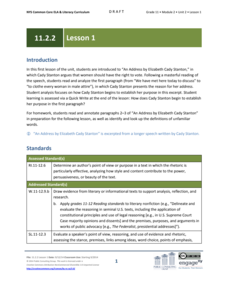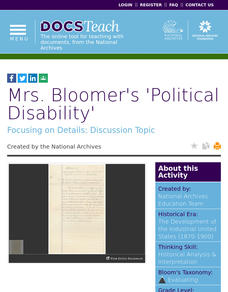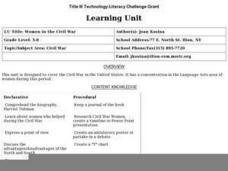EngageNY
Grade 11 ELA Module 2: Unit 2, Lesson 1
How did Elizabeth Cady Stanton use rhetoric to convince others of her views? Scholars begin reading "An Address by Elizabeth Cady Stanton," which argues that women should have voting rights. Pupils complete a Quick Write to analyze how...
DocsTeach
Mrs. Bloomer's 'Political Disability'
It's hard to believe that women had to argue for the right to vote a mere 100 years ago. Today, young historians can examine their case left behind in primary sources. Using a letter from a woman who claimed she should be able to vote...
Center for History Education
Methods of Reform: The Lowell Mill Girls
Although the girls and women who worked in the Lowell Mills are not often seen this way, they are the forbearers of the American labor movement. Pupils examine primary sources, including testimony about life at Lowell and labor laws, as...
Curated OER
The Early American Temperance/Anti-tobacco Movement
Tenth graders consider movements to regulate alcohol and tobacco use. For this Temperance Movements lesson, 10th graders compare and contrast movements in the 1800's and the modern era as they research selected primary and secondary...
Curated OER
Reform Movements (5)
In this online interactive American history worksheet, students answer 20 matching questions regarding reform movements. Students may submit their answers to be scored.
Curated OER
Women in the Civil War
Students study the Civil War era in the US with a concentration on women during this time through literature and biographies. They create a timeline or multimedia presentation as one product of this series of lessons.
Curated OER
MCCLUNG
Students research McClung's life and career, as well as the suffrage movement in Canada. They stage a "mock parliament," similar to the one that McClung staged, and they research when women and people with various ethnic origins.
Curated OER
Making More Places at the Table
Fifth graders explore the use of primary and secondary source documents. They identify primary and secondary sources. Students investigate individuals that made a difference during the American Civil Rights Movement through the use of...
Newseum
Things Change, Things Stay the Same
Securing women the right to vote was a long time coming. Over the years, some aspects of the suffrage movement changed, and some things remained the same. Pupils research three time periods and collect evidence of key people, strategies,...
Academy of American Poets
Teach This Poem: "Alice Paul" by Katharine Rolston Fisher
Powerful women need not look like Wonder Woman. After writing a paragraph about a strong woman they know, young scholars examine images of Alice Paul and then do a close reading of Katharine Rolston Fisher's poem "Alice Paul." Finally,...
Smithsonian Institution
The Suffragist: Educator's Guide for Classroom Video
Class members take on the role of historical investigators to determine why it took 40 years for women in the United States to get the right to vote. Sleuths view videos and analyze primary sources and images to gather evidence to answer...
Curated OER
Children's March Teacher's Guide, Activity 6
Learners explore the role of gender in the Civil Rights Movement. In this Children's March instructional activity, students watch "Mighty Time: The Children's March" and respond to the provided discussion questions that accompany it....
Curated OER
Civil Rights Heroes
Students explore the actions of people involved in the Civil Rights Movement. They explore the reasons for the movement and its successes and failures, and explain the sacrifices made by those who participated in the movement.
Alabama Department of Archives and History
What Were They Thinking? Why Some Some Alabamians Opposed the 19th Amendment
To better understand the debate over the 19th Amendment, class members examine two primary source documents that reveal some of the social, economic, racial, and political realities of the time period.
American Institute of Physics
The Black Scientific Renaissance of the 1970s-90s: African American Scientists at Bell Laboratories
A two-part lesson asks young scientists to research the contributions of African American scientists at Bell Laboratories. After presenting their findings, class members watch two demonstrations that introduce them to total internal...
Heritage Foundation
Voting and the Constitution
How difficult was it for everyone to get voting rights? Understanding voting rights and the fight to get them for everyone in the United States can be tricky for some learners. However, they are clarified after engaging in the...
Curated OER
LESSON 4: This is Rosa Parks
Students learn about Rosa Parks and the Civil Rights Movement.
NYC Department of Records
Citizenship and Elections: The Importance of a Ballot
Approximately 58 prcent of those eligible voted in the 2016 US Presidential election. In an attempt to impress upon learners the importance of voting and voting rights, class members examine primary source documents related to the...
Curated OER
Women's Right To Vote
Fifth graders explore the history of women's right to vote and identify two of the leaders of the suffrage movement, Alice Paul and Lucy Burns. After completing readings and discussions, they write an article for the newspaper about...
Curated OER
The Age of Reform
Students are introduced to a variety of reform movements within this lesson. They explore the beliefs and motivations of each group. Connections are made from these movements to present day situations and happenings.
Curated OER
Role of Citizens in Montgomery Bus Boycott
Students consider the role of average Americans in the Montgomery Bus Boycott. In this Civil Rights instructional activity, students listen to a lecture that outlines the details of the boycott. Students conduct further research about...
Curated OER
Examining Women's roles in education through images from the Appalachian State University Historical Photograph Collection
Eleventh graders analyze images from ASU's Historical Photograph Collection. In this American History lesson, 11th graders examine the achievements of the women's movement.
National Woman's History Museum
The Road to Suffrage
Scholars each research a different entry on the included suffrage timeline that lead to the ratification of the 19th Amendment. Using a minimum of three sources, investigators add what they have learned to a combined class Suffrage...
National Woman's History Museum
Congresswoman Jeannette Rankin
Political activist, suffragette, pacifist, and the first woman elected to Congress, Jeannette Rankin has been largely ignored in history and history textbooks. Young historians set out to rectify that situation by examining primary...

























